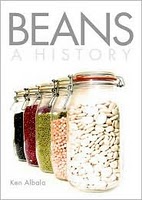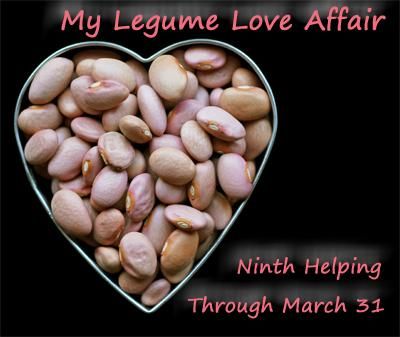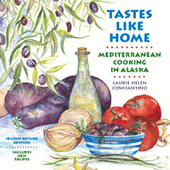 Beans: A History by Ken Albala (Berg 2007) may be the most interesting single-subject volume of food history I’ve seen; it reads as easily as a novel. Beans are Albala’s plucky hero, ever striving to overcome the cultural elite’s prejudice against what it deemed low-class trash food.
Beans: A History by Ken Albala (Berg 2007) may be the most interesting single-subject volume of food history I’ve seen; it reads as easily as a novel. Beans are Albala’s plucky hero, ever striving to overcome the cultural elite’s prejudice against what it deemed low-class trash food.
From continent to continent, Albala tracks beans’ essential role in bringing civilization and saving the masses from starvation. Despite their importance to humanity, beans get little respect. They’re too often considered as exclusively poverty food, with personal success being achieved when beans are no longer part of one’s diet.
Albala’s cultural and political history of beans is particularly interesting to read during this time of economic downturn, when too many are relying on cheap fast food for sustenance. The stigma attached to bean eating that Albala describes may partially explain why this healthy eating option is not more readily embraced by modern Americans.
Albala says the only place where beans are universally held in high regard is on the Indian subcontinent. The entire region has a vibrant bean cuisine that is accepted without regard to class lines.
That vibrancy nearly overwhelmed me as I assumed responsibility for hosting My Legume Love Affair Ninth Helping (MLLA9) this month.
The initial wave of MLLA9 recipes came mostly from Indian cooks, a cuisine with which I am largely unfamiliar. I struggled to understand the recipes, with their incomprehensible-to-me names and ingredients. Wikipedia became my new best friend.
I quickly discovered that when Indian cooks use the word “lentil,” they may be referring to what I call lentils, or they may mean chickpeas, pigeon peas, or various members of the Vigna family. Some Indian cooks use the word “gram” or “dal” instead of lentil for any of these legumes. Scientific names were my only hope for understanding the very interesting Indian recipes.
By sheer coincidence, I was reading Albala’s book. It helped clear up some of my confusion. Albala gave me a clear structure for understanding the relationships between all the new legumes to which I was being introduced.
In putting together this month’s round-up, on the assumption that some of my readers may be as confused as I was by Indian terminology, I adopted Albala’s organizational structure. To locate the beans in historical time and place, I’ve included brief quotations from Albala’s book.
For anyone interested in learning more about legumes, I highly recommend Beans: A History; it’s well worth reading.
With over 80 entries, this month’s round-up is a long read. Grab a cup of tea and settle in to learn about an enjoyable and highly diverse group of legumes and recipes!

My Legume Love Affair Ninth Helping
~~~~~~~~~~~~~~~~~~~~~~~~~~~~~~~~
Lentils: Fertile Crescent
The histories of humans and lentils are inextricably intertwined. In Beans: A History, Albala reports at page 9-11:
“The lentil was among the very first plants ever domesticated … Somewhere in the Fertile Crescent, what is today eastern Turkey, northern Iraq and Syria, some unsuspecting nomad decided to gather tiny wild lentils and plant them … The earliest charred remains of wild lentils, an indication of cooking, date from about 11000 BCE and are found at the Franchthi Cave in Greece. Somewhere around 7000 BCE or earlier the lentil began to be domesticated, the modern species of Lens culinaris most likely deriving from a wild progenitor Lens orientalis.”
1. Petra of Foodfreak, Hamburg, Germany
Braised Lentils, Peas, and Bacon with Zander Fish
(Lentils – Lens culinaris and Green Peas – Pisum sativum)
2. Simona of Briciole, California, United States
Soup with Lentils from Castelluccio
(Lentils – Lens culinaris)
3. Peter of Souvlaki for the Soul, Sydney, New South Wales, Australia
Warm Lamb Salad with Beets and Lentils
(Lentils – Lens culinaris)
4. Jaya of Spice and Curry, Kolkata, India
Shrimp and Red Lentil Fritters
(Red Lentils – Lens culinaris)
5. Sushma in My Experiments with Cooking, Singapore
Curry with Lentils, Spinach, and Garlic (Lasooni Dal Palak)
(Red Lentils – Lens culinaris and Toor Dal – split pigeon peas – Cajanus cajan)
Lupines: Europe and Andes
Lupines have a dicey history as food. They need to be carefully prepared to remove bitter alkaloids that render lupines both poisonous and unpalatable. However, Albala suggest lupines may be worth the effort to prepare. They are remarkable high in protein, which is provided at a much higher efficiency rate than beef.
“Unlike other beans, there are native species of lupines on both sides of the Atlantic. Lupinus albus and luteusaugustifolius … come from southern Europe and Lupinus mutabilis comes from the Andes and is uniquely adapted to growing at high altitudes.” Albala at 26.
Although Andean lupines are still used in heart of Inca country,
“[l]upines were completely effaced from the culinary record in the West. That is not to say ordinary people avoided them. They continued to be eaten commonly as a snack, especially at popular fairs in Italy … Lupines or lupini beans can be found in jars on the shelves of Italian grocery stores in the US and in Provencal olive mixes.” Albala at 30.
I’d planned on writing about lupini beans and bought them both dried and bottled. We tried the already-prepared bottled version first. They were inedibly salty and extremely bitter. No one who ate one was willing to try a second. I soaked them overnight and removed the excessive salt, but the nasty bitterness remained. By unanimous demand, the bottled beans were discarded.
After that, I lost my enthusiasm for the multi-day soaking process necessary to render dried lupini beans edible. Since I have the dried beans, and Mark Bittman claims they’re good, I’ll try them someday; just not this month.
Fava Beans: Europe
Though not much used in the United States, fava beans are wildly popular in Europe and the Eastern Mediterranean basin. Albala tells us at 33-34 that fava beans were “among the early Fertile Crescent domesticates,” but
“the origin of Vicia faba is unknown and its wild ancestor is probably extinct. … The oldest archaeological remains of favas were found in a site near Nazareth dated between 6500 and 6000 BCE … Oddly, the archaeological record is otherwise silent and the next findings date from several thousand years later. Exactly when and where favas were domesticated remains a complete mystery, and they quite suddenly appear in Bronze Age sites in the third millennium BCE in places as far flung as Spain and Portugal, northern Italy and Switzerland, Greece and the Middle East. … most likely they spread from the Fertile Crescent in every direction, becoming the premier bean of the ancient world. When the word bean is used in European texts prior to 1492, it is almost always the fava.”
1. Maria of Organically Cooked, Hania, Crete, Greece
Mixed Bean Stew (Pallikaria-Παλλικάρια)
(Fava Beans – Vicia faba, Lentils – Lens culinaris, Chickpeas – Cicer arietinum, Black-eyed Peas – Vigna unguiculata subsp. unguiculata, White Beans – Phaseolus vulgaris)
2. Sra of When My Soup Came Alive, India
Fresh Fava Bean and Eggplant Curry
(Fava Beans – Vicia faba)
Peas, Chickpeas and Pigeon Peas
Peas’ sweet flavor has made it more popular than most legumes. Peas also “have the broadest range geographically and climactically than any other legume … from the subtropics to cold and arid climates.” Albala at 75-76. According to Albala, peas were
“one of the earliest domesticated plants … archaeological remains of which date back as far as 8000 BCE. Its wild progenitor was probably the tall humile type distributed throughout the Levant, eastern Turkey, Syria and northern Iraq. … [A]ll the cultivated varieties used today are Pisum sativum. This domesticated pea spread rapidly, reaching Western Europe by 4000 BCE and thereafter south to Egypt, north into the Caucasus and Eastern Europe and east eventually reaching India by about 2000 BCE.”
1. Matt of Hurst Bean Blog, Indianapolis, Indiana, United States
Split Pea and Asparagus Soup
(Green Peas – Pisum sativum)
2. Laurie of Mediterranean Cooking in Alaska, Anchorage, Alaska, United States
Split Pea Soup with Ham Hocks
(Green Peas – Pisum sativum)
3. Ragee of Simply Innocence, Copell, Texas, United States
Sweet Green Peas and Fresh Fenugreek Leaves in Spicy Cream Sauce (Methi Matar Malai)(Green Peas – Pisum sativum)
Albala points out at 81-2 that like peas, chickpeas have
“largely escaped the ignominy of beans. Though … they are hardly a pea at all. They are properly a bean. … The origin of chickpeas is once again in the Fertile Crescent … in Turkey and Syria the oldest carbonized chickpeas have been found, about 10,000 years old, but these are small and may have been gathered wild. Larger seeded, domesticated samples are found in Bronze Age sites in Israel and Jordan. They made their way to Greece by 6000 BCE and France a few thousand years later, and, like the other beans, eventually to Africa and India. … There are two distinct types of chickpea – the large smooth-skinned variety common in the Mediterranean called Kabuli and smaller darker chickpeas more common in India and thereabouts called Desi.”
1. Vani of Mysoorean, United States
Mexican Bean and Vegetable Burger
(Chickpeas – Cicer arietinum)
2. Trupti of Recipe Center, Virginia, United States
Chickpea Burgers
(Chickpeas – Cicer arietinum)
3. Nuria of Spanish Recipes, Barcelona, Spain
Oven-Baked Rice with Chickpeas, Pork, and Morcilla (Arroz al Horno)
(Chickpeas – Cicer arietinum)
4. Sree of Taste Spell, United States
Chickpeas in Spicy Curry Sauce (Chole Masala)
(Chickpeas – Cicer arietinum)
5. Divya of Easy Cooking, Channai, India
Curried Garbanzo Beans with Fresh Fenugreek Greens (Methi Chole)
(Chickpeas – Cicer arietinum)
6. Maya of Stories from Emona, Ljubljana, Slovenia
Tomato and Onion Sautéed Chickpeas with Scrambled Eggs and Rosemary Roasted Potatoes
(Chickpeas – Cicer arietinum)
7. Varsha of Will-O’-the-Wisp, Seattle, Washington, United States
Garbanzo Bean and Spinach Curry (Palak Chole)
(Chickpeas – Cicer arietinum)
8. Asha of Foodie’s Hope, North Carolina, United States
Brown Chickpea Masala (Chana Masala)
(Desi Chickpeas – Cicer arietinum)
9. Hema of Salt to Taste, Bayonne, New Jersey, United States
Spicy Chickpeas Fritters (Masala Vadai)
(Chana Dal – split skinless Desi chickpeas – Cicer arietinum)
10. Sanghi of Sanghi’s Food Delights, Singapore
Sweet Steamed Dumplings (Kolukattai)
(Chana Dal – split skinless Desi chickpeas – Cicer arietinum)
11. Sanghi of Sanghi’s Food Delights, Singapore
Spicy Chickpeas Fritters with Buttermilk Curry (Masala Vadai Mor Kuzhambu)
(Chana Dal – split skinless Desi chickpeas – Cicer arietinum)
12. Indrani of Appyayan, Singapore
Fry Bread Stuffed with Spicy Chickpeas (Radhaballavi-Dal Puri)
(Chana Dal – split skinless Desi chickpeas – Cicer arietinum)
13. Sonal of Khaane Ke Shaukeen, Singapore
Fry Bread with Chickpea Flour Stuffing (Besan Kachori)
(Chana Dal Flour – Desi chickpeas – Cicer arietinum)
14. Rinku of Cooking in Westchester, Westchester County, New York, United States
Radish and Scallion Pakoras with Chickpea Batter
(Chana Dal Flour – Desi chickpeas – Cicer arietinum)
For Americans, Pigeon Peas are the least well-known of the “peas” catalogued by Albala. Cajanus cajan is also known as the Congo or gunga pea and, in the Caribbean, as gandules. Albala says at 86,
“They probably originated in India, where they are split, thereafter called toor dal, and cooked down with spices until they disintegrate. … To this day the majority are grown in India. From there they spread basically to every dry tropical region where peas do not grow well. Thus in East Africa they found a welcome home, though some speculate that they originated [t]here.”
1. Varsha of Will-O’-the-Wisp, Seattle, Washington, United States
Spicy Vegetable and Pigeon Pea Soup (Sambar)
(Toor Dal – split pigeon peas – Cajanus cajan)
2. Lubna of Yummy Food, Bangalore, India
Spicy Vegetable Soup (Sambar) with Shallots
(Toor Dal – split pigeon peas – Cajanus cajan)
3. Lubna of Yummy Food , Bangalore, India
Cucumber and Pigeon Pea Soup (Dosakaya Pappu)
(Toor Dal – split pigeon peas – Cajanus cajan)
4. Saritha of My Kitchen’s Aroma, Sharjah, United Arab Emirates
Coconut and Pigeon Pea Chutney (Kandi Pappu-Cobari Pachadi)
(Toor Dal – split pigeon peas – Cajanus cajan)
5. A&N of Delectably Yours, Atlanta, Georgia, United States
Lemon Pigeon Pea Soup (Rasam)
(Toor Dal – split pigeon peas – Cajanus cajan)
6. Usha of Veg Inspirations, North Carolina, United States
Bitter Gourd with Pigeon Pea-Tamarind Sauce (Pahakai Pitlai Kozhumbu)(Toor Dal – split pigeon peas – Cajanus cajan, Chana Dal – split skinless Desi chickpeas – Cicer arietinum, and Urad Dal – split black gram – Vigna mungo)
7. Priyanka of Not Yet 100, India
Pigeon Peas and Tomatoes (Tamatar Dal)
(Toor Dal – split pigeon peas – Cajanus cajan)
8. Priya of Priya’s Easy N Tasty Recipes, Paris, France
Peppery Chayote and Pigeon Pea Stew (Chayote Pepper Sambhar)
(Toor Dal – split pigeon peas – Cajanus cajan)
9. Chitra of Ratatouille-Anyone Can Cook, Bangalore, Karnataka, India
Crispy Bean-Rice Pancakes with Curry Leaf Chutney (Moru Moru Adai)
(Toor Dal – split pigeon peas – Cajanus cajan and Chana Dal – split skinless Desi chickpeas – Cicer arietinum)
10. Le of Heartful Concoctions, United States
Spicy Pigeon Pea, Eggplant, Drumstick, and Green Mango Soup
(Toor Dal – split pigeon peas – Cajanus cajan)
Oddballs and Villains
“Every family has its black sheep oddballs and criminal types. Beans are no different. They seem odd only by comparison to the respectable members of the Fabaceae family, and many have found very happy homes throughout the world. Some of these are real degenerates though, surviving on the very margins of the human food supply, mostly as famine foods. … Although in no way related to each other, these beans [are included in a single chapter] because few readers are likely to be acquainted with them. This rogues’ gallery will include Lathyrus and Lablab, the Vetch clan, as well as the more obscure Canavalia, Mucuna and Macrotyloma, and the beautifully seductive Psophocarpus tetragonolobus…” Albala at 90.
1. Laurie of Mediterranean Cooking in Alaska, Anchorage, Alaska
Santorini Fava with Capers (Fava Pantremeni-Φάβα Παντρεμένη)
(Santorini Fava, Lathyrus clymenum L.)
2. Divya of Dil Se, Los Angeles, California, United States
Hyacinth Bean Stew (Mochai Kuzhambu)
(Hyacinth Beans – Lablab purpureus)
Mung and the Vignas: India
In India, beans escaped the low-class reputation in which they were held elsewhere in the world. Albala at 107-08 attributes this to a variety of political and religious reasons which
“catalyzed the valorization of beans in a way that was diametrically opposed to Western Civilization’s denigration. Beans thus became an essential staple crop in India, the primary source of protein for the majority of people… Although the majority of modern Indians are not vegetarian, dense population and the high price of meat has meant the majority still receive most of their calories from vegetables, primarily grains and beans. As we have seen, Fertile Crescent legumes such as lentils and chickpeas were introduced at a very early date. But the subcontinent also had its own species, the most important of which are the Asiatic Vigna species or as they are known in India ‘grams’: mung beans (V. radiata or green gram), urd beans (V. mungo or black gram) as well as moth beans (V. aconitifolia), and rice beans (V. umbellata). … The Taxonomic distinction of the Vigna beans is also a relatively recent phenomenon. Many were classed as Phaseolus until that name was reserved exclusively for New World species…These Asian Vigna species were also given a sub-genus classification called Ceratotropis.”
1. Deeba of Passionate About Baking, North India
Mung Bean Pancakes
(Moong Dal – split mung beans – Vigna radiata)
2. Sanghi of Sanghi’s Food Delights, Singapore
Sweet Mung Bean Pudding (Kheer)
(Moong Dal – split mung beans – Vigna radiata)
3. Saritha of My Kitchen’s Aroma, Sharjah, United Arab Emirates
Sweet Mung Bean Pudding (Payasam or Kheer)
(Moong Dal – split mung beans – Vigna radiata)
4. Aparna of Ap’s Kitchen, Mangalore, Saudi Arabia
Spiced Mung Beans and Rice (Sheeth ani Mooga Dali Bette)
(Moong Dal – split mung beans – Vigna radiata)
5. Priya of Priya’s Easy N Tasty Recipes, Paris, France
Mung Bean Fritters (Green Gram Medhu Vada)
(Mung Beans – Vigna radiata)
6. Priya of Priya’s Easy N Tasty Recipes, Paris, France
Spinach and Mung Bean Soup
(Mung Beans – Vigna radiata)
7. Kalva of Curry in Kadai, Florida, United States
Steamed Rice-Bean Cakes with Garlic-Spice Powder (Kanchee Idli and Vellulli Karam)
(Urad Dal – split black gram – Vigna mungo)
8. Ashwini of Nanna Adige, Dallas, Texas, United States
Steamed Bean Cakes (Dal Idli)
(Urad Dal – split black gram – Vigna mungo, Moong Dal – split mung beans – Vigna radiata, and Toor Dal – split pigeon peas – Cajanus cajan)
9. Sonal of Khaane Ke Shaukeen, Singapore
Bean Dumplings in Yogurt (Dahi Vada)
(Urad Dal – split black gram – Vigna mungo and Moong Dal – split mung beans – Vigna radiata)
10. Priyanka of Not Yet 100, India
Crisp Flatbread with Black Gram Stuffing (Urad Dal Parathas)
(Urad Dal – split black gram – Vigna mungo)
11. Lavanya of vividharuchulu, Redmond, Washington, United States
Rice-Bean Pancakes (Plain Dosa)
(Urad Dal – split black gram – Vigna mungo)
12. Sharmistha of Cook-a-Doodle-Do, Hyderabad, India
Indian Bread with Bean-Asafoetida Stuffing (Hing er Kochuri)
(Urad Dal – split black gram – Vigna mungo and Chana Dal – split skinless Desi chickpeas – Cicer arietinum)
13. Priya of Food and Laughter, India
Spicy “Gunpowder” Seasoning (Molaha Pudi)
(Urad Dal – split black gram – Vigna mungo and Chana Dal – split skinless Desi chickpeas – Cicer arietinum)
Albala concludes his Vigna chapter with the Adzuki bean at 113:
“Although clearly thematically separate from the discussion in this chapter, there remains one more relative in the Ceratotropis sub-genus. He is much bigger than his brothers, and more boisterous, with his bright red coat. He is also a little sweeter and something about the adzuki bean (V. angularis) makes you feel like celebrating.”
1. Apu of Annarasa, United States
Adzuki Beans with Swiss Chard
(Adzuki Beans – Vigna angularis)
2. Lucy of Nourish Me, Melbourne, Australia
Aduki and Celery Leaf Soup
(Adzuki Beans – Vigna angularis)
Black-eyed Peas: Africa, Soul Food
“Vigna unguiculata, at least according to botanists, is a cousin to the Asian Vigna species. … The black-eyed pea is, in any case, a resolutely and characteristically African bean. Archeological evidence from the Chad basin suggests that the pastoral people who migrated into this area around 1800 BCE began to switch to an agricultural regime by about 1200 BCE … with the staples of pearl millet and black-eyed peas. This bean has thus always played a central role in African agriculture and was brought with slaves to the Americas where it remains an indelible marker of African-American identity. … In the Old World, black-eyed peas spread northward and eastward in ancient times and the earliest recorded evidence of their use is not in Africa but among the Greeks and in India. … Africa, however, is the real home of black-eyed peas and West Africa still produces roughly 90 percent of the world supply.” Albala 117-19.
1. Pavani of Cook’s Hideout, New Jersey, United States
Black-Eyed Pea Burgers
(Black-eyed Peas – Vigna unguiculata subsp. unguiculata)
2. Keerthana of Kitchen Vibes, Germany
Curried Black-Eyed Peas (Lobhia Curry)
(Black-eyed Peas – Vigna unguiculata subsp. unguiculata)
3. Sia of Monsoon Spice, United Kingdom
Curried Black-Eyed Pea Sprouts with Bottle Gourd (Lauki-Lobia Curry)
(Black-eyed Peas – Vigna unguiculata subsp. unguiculata)
4. Rachel of The Crispy Cook, Saratoga County, New York, United States
Black-Eyed Pea Salad with Preserved Lemons
(Black-eyed Peas – Vigna unguiculata subsp. unguiculata)
Phaseolus vulgaris: Mexico and the World
The common bean, Phaseolus vulgaris, wasn’t known outside the Americas until after 1492. It is now grown throughout the world, and comes in a myriad of wildly different shapes and sizes. Albala describes its origins at 127-28:
“The wild ancestor of Phaseolus spread from Northern Mexico to Argentina and it was domesticated independently both in the Peruvian Andes…as well as in Mexico… Exactly when these events took place is more difficult to determine, partly because archeological remains are sparse in the humid environment of Mesoamerica… Remains of P. vulgaris from a cave in the Peruvian Andes have been radiocarbon dated at about 6000 BCE and they may have been domesticated well before that … it is safest to say that these beans were domesticated several thousand years ago, without indicating a precise chronology.”
Albala goes on to describe in fascinating detail the dramatic changes for both P. vulgaris and humans that occurred after Columbus encountered the New World. As P. vulgaris was incorporated into cultures across the world, the numerous bean varieties with which we are now familiar evolved and came into common use.
1. Katerina of Culinary Flavors, Athens, Greece
Bean Salad
(White Beans – Phaseolus vulgaris)
2. Emiglia of Tomato Kumato, Paris, France
Minestrone
(White Beans – Phaseolus vulgaris)
3. Valli of More Than Burnt Toast, British Columbia, Canada
Better for You Taco Salad
(Red Kidney Beans – Phaseolus vulgaris)
4. Maya of Konkan World, Texas, United States
Minestrone Soup
(Red Kidney Beans – Phaseolus vulgaris)
5. Laura of The Spiced Life, Midwest, United States
Kidney Beans with Cardamom-Yogurt Sauce
(Red Kidney Beans – Phaseolus vulgaris)
6. Neha of Tasty Recipes, Singapore
Red Kidney Bean (Rajma) Curry
(Red Kidney Beans – Phaseolus vulgaris)
7. Renuka of Fusion,Tamilnadu, India
Curried Red Kidney Beans (Rajma Gravy)
(Red Kidney Beans – Phaseolus vulgaris)
8. Nina of Miss Adventure at Home, Hamilton, Ontario, Canada
Four Bean Salad
(Red Kidney, Green, and Yellow Beans – Phaseolus vulgaris and Chickpeas – Cicer arietinum)
9. Lisa of Lisa’s Kitchen, London, Ontario, Canada
Spicy White Bean and Turnip Soup
(Cannellini Beans – Phaseolus vulgaris)
10. Lavi of Home Cook’s Recipes, India
Amaranth Greens and White Kidney Bean Curry (Sirukeeri Rajma Curry)
(Cannellini Beans – Phaseolus vulgaris)
11. Swarna of Saivam, Fremont, California, United States
Portabella Mushrooms Stuffed with Cannellini Beans
(Cannellini Beans – Phaseolus vulgaris)
12. Allison of Local Lemons, Berkeley, California, United States
Spring Cannellini Bean Soup with Romano Croutons
(Cannellini Beans – Phaseolus vulgaris)
13. Lori of Taste with the Eyes, San Pedro, California, United States
Cannellini Bean Asian Slaw with Miso Sesame Dressing
(Cannellini Beans – Phaseolus vulgaris)
14. Erin of You-Name-It-Free, Basel, Switzerland
Royal Purple Baked Beans
(Black Beans – Phaseolus vulgaris)
15. Tigerfish of Teczcape-An Escape to Food, Singapore and California, United States
Spicy Pinto Beans
(Pinto Beans – Phaseolus vulgaris)
16. Katie of Eat This., Haslett, Michigan, United States
Andean Pinto Bean and Butternut Squash Soup
(Pinto Beans – Phaseolus vulgaris)
17. Giff of The Constables’ Larder, New York, United States
Pancetta, Chard, Cranberry Bean and Gouda Gratin
(Cranberry Beans – Phaseolus vulgaris)
18. Manju of Mirch Masala, Seattle, Washington, United States
Barley and Mixed Bean Soup
(Beans – Phaseolus vulgaris)
Limas and the Lesser Phaseoli: Andes
After P. vulgaris (see above), the most important of the 55 separate Phaseolus species is the lima bean, Phaseolus lunatus. Albala says at 191-93 that the lima
“is native to the Andes. Those found at the Guitarrero Cave in the highlands of Peru were domesticated even before both the common bean and corn. … They are roughly contemporary with many Old World sites of bean domestication. … Like P. vulgaris, the lima bean was taken to Europe sometime in the 16th century, and also to the Philippines with the Manila galleons. It is widely grown throughout SE Asia, particularly in Burma. It was also taken to Africa from Brazil, and is now the primary dried bean eaten in the tropics there and in Madagascar. … It never really caught on as a major food in Europe, probably because the climate is not ideal for its growth.”
1. Laurie of Mediterranean Cooking in Alaska, Anchorage, Alaska
Pan-Fried Salmon with Curly Endive and Christmas Lima Beans & Christmas Lima Bean Salad
(Lima Beans – Phaseolus Lunatus)
2. Susan of The Well-Seasoned Cook, New York, United States
Lima Bean and Artichoke Soup
(Lima Beans – Phaseolus Lunatus)
Tepary Beans: Native Americans
I tried tepary beans for the first time this month because I wanted to have at least one recipe for each of Albala’s 11 bean chapters. Having done so, it’s hard to understand why it isn’t more widely available; it’s one of the best beans I’ve ever tasted. Albala explains at 203-04 that the origins of the tepary bean, Phaseolus acutifolius,
“are debated since wild forms are found stretching from the Southwest through Central America. Archaeological remains in Puebla, Mexico, date back 5,000 years, but it is not known where it was first domesticated. A strong claim is made for domestication, perhaps independently, in the [American] Southwest where wild varieties can still be found. … As recently as the 1930s, the Tohono O’odham [formerly called Papago Indians] grew 1.5 million pounds of teparies a year. Half a century later the bean had almost completely disappeared.”
Laurie of Mediterranean Cooking in Alaska, Anchorage, Alaska, United States
Tepary Bean and Vegetable Stew
(Tepary Bean – Phaseolus acutifolius)
Soy: China, Japan and the World
Soy is “the most widely grown bean on the plant,” according to Albala at 209, though most of it is processed “into milk and curd and made into a variety of condiments bearing little resemblance to the humble bean.” Albala attributes this to soybean’s slight bitterness and its “unpleasant beany odor” (noting that green Japanese edamames are “a very specific cultivar bred for its mild flavor and consumed immature”).
“Glycine max is the Latin name for the soybean, which was descended from another wild bean, Glycine soja. … [It] was first cultivated in the eastern half of Northern China, based on recent DNA evidence, … about 3,000 years ago, though some make a claim for Mongolia. That makes it a relative latecomer among the ancient beans, but with an extremely long pedigree nonetheless. … Although archaeological evidence may eventually push back the origin of soy domestication, 1100 BCE is for the moment the earliest certain date.” Albala 209-10.
1. Laurie of Mediterranean Cooking in Alaska, Anchorage, Alaska, United States
Mushroom and Edamame Risotto with Homemade Pancetta
(Soybeans – Glycine Max)
2. Soma of eCurry, Texas, United States
Stir Fried Ginger Tofu and Veggies with Brown Rice
(Soybeans – Glycine Max)
3. Christine of Kit’s Chow, Kitsilano, British Columbia, Canada
Savory Tofu Puffs
(Soybeans – Glycine Max)





